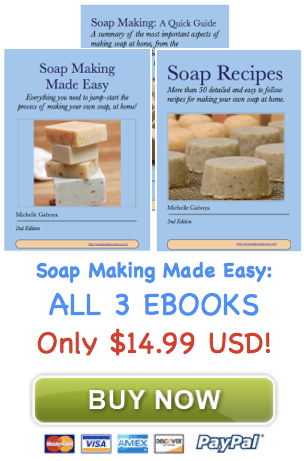This article briefly explains the properties of lye and the importance for lye as part of the soap making process. Please click here to read our full, comprehensive article on soap making with lye, including a free basic soap recipe.
There are three basic ingredients which, when mixed, will yield a simple bar of soap:
Fats, Lye, and Water.
The first ingredient in soap, the fats and oils, can be derived from either animal or vegetable fat. Beef tallow, bacon grease, lard, or any other type of animal fat can be used to make soap; palm, corn, canola, and olive are common ingredients for vegetable-based soaps.
Typically, soaps made from vegetable oils are softer than those made with animal fat, and tend to be better for skin because they don’t clog pores. With handmade soap, you would have absolute control over the choice of which oils to use.
The second ingredient, lye (also called sodium hydroxide, potash, or caustic soda), used to be hand-extracted from wood ashes. It is now commonly found in many hardware and grocery stores, and is the ingredient that hydrolyzes the oils or fats, and turns them into soap.
As for the third ingredient, water, do not make the common mistake of getting it from the tap – a frequent error amongst the uninitiated. The minerals and other additives in tap water make it less than ideal for soap-making. It has been found to be best to use distilled, bottled, or spring water.
Mixing these three ingredients together will make a plain bar of soap. However, the process of how to actually mix them in the right proportions, at the right times and in the right order, to produce the very soap you had in mind, is an art in itself. Of course, once you have the process down, the fun begins and you can get much more creative: add essential oils for pleasing or therapeutic scents, various colorants to achieve the desired hue for your soap, sand or pumice to make exfoliating soap, etc..
Don’t forget to read our full, comprehensive article on soap making with lye, including a free basic soap recipe by clicking here.
Over to you: do you have any tips for using lye? Let us know in the comments below and share your favourite tricks for how to make soap with our readers!
Take the next step
Make sure you download our FREE comprehensive beginners guide, ‘How To Make Soap At Home’, by clicking here.
If you are ready to get serious about soap making, we have a special offer on our Soap Making Ebooks range, with a risk free 60 day money back guarantee! Also available for Kindle, iPhone, iPad, Android and all major Ebook reader platforms.
